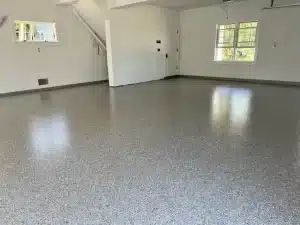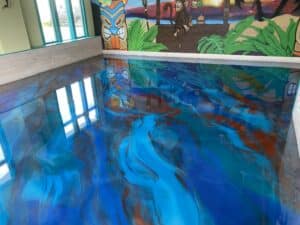Epoxy Basics & The Importance of Flooring
When you step into any space, one of the first things you interact with, often unconsciously, is the floor. It’s not just about what’s underfoot though. Flooring impacts the aesthetics, safety, and functionality of an environment. For those searching for durable, cost-effective, and eco-friendly flooring solutions, epoxy floor coatings offer an intriguing answer. Why? Because they provide a blend of longevity, ease of maintenance, and visual appeal unrivaled by many other flooring types.
Epoxy flooring consists of two main components: resins and hardeners. When combined, these materials create a robust surface that adheres effectively to its base floor, resulting in a durable and resilient finish. This makes it suitable for a wide range of spaces, from industrial warehouses to residential living rooms.
For the environmentally-conscious architect or builder, understanding the basics of epoxy and recognizing the critical role flooring plays in sustainable design is crucial. Epoxy flooring can be part of the solution to balancing client demands with environmental standards, offering a surface that is both attractive and in line with green building certifications.
Quick Epoxy Overview:
– Durability: Highly resistant to wear and tear, making it last longer.
– Aesthetics: Available in various colors and textures for customized designs.
– Safety: Can be slip-resistant, enhancing the safety of a space.
– Eco-friendly: Some options are low in volatile organic compounds (VOCs), making them better for the environment.

Understanding Epoxy Floor Coatings
Epoxy floor coatings are like superheroes for floors. They protect, beautify, and extend the life of the surfaces they cover. Let’s dive into the types of epoxy coatings, their benefits, and where they’re best used.
Types of Epoxy Coatings
- 100% Solids Epoxy: This is the tough guy. It’s all epoxy, no fillers. It creates a thick, durable layer that’s resistant to almost everything – chemicals, abrasions, and heavy traffic. Think of it as the body armor for floors.
- Water-Based Epoxy: This is the more approachable type. It’s easier to apply and clean up because it’s water-based. It’s not as tough as 100% solids but still provides a strong protective layer. Ideal for less intense environments.
- Solvent-Based Epoxy: The fast mover. Solvent-based epoxies dry quickly and can be applied in cooler temperatures. They’re strong but come with a strong smell and require careful handling.
Benefits of Epoxy Coatings
- Durability: Epoxy coatings are like a shield. They protect floors from wear, making them last longer. They’re tough against scratches, spills, and stains.
- Aesthetics: You can make your floor look like a piece of art. Epoxy comes in various colors and patterns, giving you the freedom to customize your space.
- Safety: No more slipping and sliding. Epoxy coatings can be made slip-resistant, making your spaces safer for everyone.
Applications of Epoxy Coatings
- Industrial: In factories and warehouses, where floors need to be super tough, 100% solids epoxy is a popular choice. It can handle heavy machinery and spills without a sweat.
- Commercial: Shops, offices, and showrooms benefit from water-based and solvent-based epoxies. They provide a balance of durability and aesthetics, making spaces look good while still being practical.
- Residential: In homes, garages, and basements, epoxy coatings protect and beautify. They’re an excellent choice for areas that see a lot of foot traffic or need a little extra durability.
Epoxy floor coatings offer a versatile, durable, and attractive solution for nearly any space. Whether you’re looking to toughen up an industrial floor or add a bit of flair to your home garage, there’s an epoxy coating that fits the bill. With proper preparation and application, an epoxy-coated floor can provide years of service, combining form and function in a way few other flooring options can.
Preparing for Epoxy Coating Installation
Before diving into epoxy floor coatings, it’s crucial to understand the groundwork needed to ensure a successful application. This preparation is not just a preliminary step; it’s the foundation that determines the longevity and effectiveness of your epoxy coating. Let’s break down this process into manageable chunks, starting with surface preparation techniques, the importance of moisture testing, and the role of thorough cleaning.
Surface Preparation Techniques
To kick things off, the surface of your floor needs to be ready to bond with the epoxy. This means it should be clean, dry, and have a texture that the epoxy can grip onto. Here are the main techniques used:
- Etching: This involves applying an acid-based solution to the floor to roughen up the smooth concrete surface. It’s like giving the floor a little bit of “tooth” so the epoxy has something to hold onto.
- Grinding: For a more aggressive approach, especially in industrial settings, grinding the floor with a diamond-tipped grinder creates the ideal surface for epoxy adhesion. It’s like sanding wood before painting; the rougher surface ensures a stronger bond.
- Cleaning: Simple but vital. This step removes any oils, grease, or residues that could prevent the epoxy from adhering properly. A clean surface means a smooth application process and a durable finish.
Importance of Moisture Testing
Moisture is the arch-nemesis of epoxy coatings. Before you even think about mixing your epoxy, you need to ensure that the concrete slab is as dry as a bone. Here’s why and how:
- Prevention: Moisture trapped under the epoxy can lead to peeling, bubbling, and a whole host of problems. Testing for moisture prevents these issues by ensuring the floor is ready for coating.
- Methods: There are a few ways to test for moisture, including the plastic sheet method (taping a plastic sheet to the floor and checking for condensation) or using a moisture meter designed for concrete.
- Solutions: If you find moisture, don’t fret. Solutions range from applying a moisture barrier before the epoxy to using specific epoxy formulations designed for damp surfaces.
By taking the time to properly prepare your floor through etching, grinding, and cleaning, and by ensuring the absence of moisture, you’re setting the stage for a successful epoxy application. This not only guarantees a finish that looks great but also one that lasts, making it a wise investment for any space. The key to a long-lasting epoxy floor lies beneath the surface. With the floor ready, it’s time to dive into the exciting part—mixing and applying your epoxy coating for a transformation that combines aesthetics with unparalleled functionality.
Installation Process of Epoxy Floor Coatings
The journey from a plain concrete floor to a polished, durable surface doesn’t have to be complicated. Let’s break down the process of installing epoxy floor coatings into simple steps: mixing, applying, and maintaining your new floor.
Mixing Epoxy Properly
The first step in the installation process is to mix your epoxy coating correctly. Epoxy consists of a resin and a hardener; when mixed together, they react and start to cure. It’s crucial to follow the 2:1 ratio (resin to hardener) for most products, but always check the manufacturer’s instructions for the best results.
Tools you’ll need:
– Mixing sticks
– Clean buckets
– A drill with a mixing paddle (for larger areas)
Techniques:
1. Measure out your resin and hardener carefully.
2. Pour the hardener into the resin (not the other way around) to ensure a thorough mix.
3. Mix slowly to avoid creating air bubbles, scraping the sides and bottom of the bucket as you go.
4. For best results, transfer the mixed epoxy into a new bucket and mix again to catch any unmixed parts.
Applying Epoxy Coatings
Once mixed, the clock starts ticking. Epoxy has a limited working time before it begins to harden, so plan your application method in advance.
Techniques:
– Use a roller for large, open areas and a brush for edges and tight spots.
– Apply in thin, even coats to avoid bubbles and ensure a smooth finish.
Thickness and Patterns:
– Most floors require a thickness of about 2mm. Check the product specifications for guidance.
– For a decorative finish, consider using multiple colors or adding flakes or metallic pigments. Apply the base coat first, then add your decorative elements while the base is still tacky.
Curing and Maintenance
Time:
– Epoxy coatings typically need at least 24 hours to become touch-dry, but full curing can take up to 7 days. Factors like temperature and humidity can affect curing times.
Conditions:
– Keep the area well-ventilated but avoid drafts that could introduce dust.
– Maintain a consistent temperature as recommended by the epoxy manufacturer.
Maintenance Tips:
– Once cured, epoxy floors are relatively low maintenance. Regular sweeping and occasional mopping with a mild detergent are all it takes to keep your floor looking new.
– For areas with heavy traffic or the potential for spills, consider applying a topcoat for extra protection.
By following these steps—mixing your epoxy properly, applying it with care, and allowing it to cure under the right conditions—you’ll ensure a successful installation that looks great and lasts for years. The beauty of an epoxy floor is not just in its appearance but also in its durability and ease of maintenance. With the right preparation and care, your epoxy floor will be a functional and stylish addition to any space.
Common Questions and Concerns
When considering epoxy floor coatings, several questions naturally arise. Let’s address the most common concerns regarding cost, longevity, slip resistance, and how epoxy compares to other flooring options like tile.
How Long Will Epoxy Floor Coating Last?
The longevity of epoxy floor coatings can vary based on several factors, including the quality of the installation, the level of foot or vehicle traffic, and how well the floor is maintained. Generally, a professionally installed epoxy floor can last anywhere from 10 to 20 years. Regular cleaning and avoiding harsh chemicals can extend the life of your epoxy flooring. The key to long-lasting epoxy floors lies in proper preparation and application.
Is Epoxy Floor Coating Worth It?
Evaluating whether epoxy flooring is a good investment involves comparing it to other flooring options in terms of cost, durability, and appearance. Epoxy floors are renowned for their durability, aesthetic appeal, and safety features such as slip resistance. They can transform a bland space into a bright, clean, and safe environment. When considering the cost over the lifespan of the flooring, epoxy offers excellent value, especially in settings where durability and ease of maintenance are paramount.
Is Epoxy Floor Cheaper Than Tile?
When it comes to cost comparison, initial installation costs for epoxy might be higher than those for standard tile. However, considering the long-term value, epoxy floors often emerge as the more cost-effective choice. Tiles can crack and may require grout maintenance or replacement, which adds to their long-term cost. Epoxy, on the other hand, forms a seamless surface that is resistant to cracking, easy to clean, and less prone to damage. Over time, the maintenance and replacement costs for tile can exceed the initial investment in an epoxy floor.
Factors Influencing Longevity and Value
- Quality of Installation: A professional, thorough installation is crucial for maximizing the lifespan of an epoxy floor.
- Usage and Traffic: High-traffic areas may see a shorter lifespan, but proper care can mitigate wear and tear.
- Maintenance Routine: Regular cleaning and maintenance can significantly extend the life of an epoxy floor.
Maintenance and Expectations
Epoxy floors are straightforward to maintain. Regular sweeping and occasional mopping with a pH-neutral cleaner are generally all that’s required to keep the floor looking new. Avoiding harsh chemicals and abrasive cleaning tools will protect the floor’s finish.
Investment and Comparison
Epoxy floors are an excellent investment for those looking for a balance between aesthetics, durability, and cost. While the initial outlay might be higher than some alternatives, the long-term savings on maintenance and replacement, combined with the functional benefits of durability and ease of cleaning, make epoxy a compelling choice.
Slip Resistance
A common concern is whether epoxy floors are slippery. Most epoxy floor coatings include a nonslip additive that provides traction, even in wet conditions. This makes epoxy floors a safe option for areas where spills or moisture might be a concern.
In conclusion, epoxy floor coatings offer a blend of longevity, aesthetic appeal, and value that is hard to beat. Whether you’re renovating a commercial space, a garage, or considering epoxy for residential use, it’s a flooring option worth considering. With minimal maintenance, an epoxy floor can keep your space looking vibrant and welcoming for years to come, making it a wise investment for a wide range of applications.

Conclusion
In wrapping up our ultimate guide to epoxy floor coatings, let’s touch on the key points that make this flooring solution stand out: sustainability, the unparalleled service of Topcoat Services, and the exciting future trends in the industry.
Sustainability
Epoxy floor coatings are not just about the sleek finish or the tough surface they provide; they’re also about making a positive impact on the environment. With their long lifespan, epoxy floors reduce the need for frequent replacements, thus minimizing waste. Moreover, their durability means less use of harsh cleaning chemicals, aligning perfectly with a greener lifestyle. Choosing an epoxy floor is a step towards sustainable living, without compromising on style or functionality.
Topcoat Services
At Topcoat Services, we’re committed to more than just laying down a floor. We’re about crafting solutions that fit your unique needs and vision. Our expertise in epoxy floor coatings ensures that your space isn’t just equipped with a floor that’s built to last but is also designed to reflect your style. We guide you through every step of the process, from selecting the right type of epoxy to the final touches, ensuring a seamless experience and a floor that exceeds your expectations. Partner with us, and let’s transform your space together.
Future Trends
The world of epoxy floor coatings is changing, with new technologies and trends emerging constantly. We’re seeing a shift towards more environmentally friendly materials, with low-VOC epoxies becoming more popular. There’s also a growing trend in customizing floor designs, with metallic and flake finishes offering unique aesthetics that can turn any floor into a statement piece. As we look to the future, we anticipate further innovations that will make epoxy flooring even more durable, sustainable, and versatile.
In conclusion, epoxy floor coatings offer a blend of durability, aesthetics, and environmental friendliness that’s hard to beat. Whether you’re renovating a commercial space, a garage, or considering epoxy for residential use, it’s a flooring option worth considering. With Topcoat Services by your side, you’re choosing a partner dedicated to excellence, sustainability, and innovation. Let us help you transform your space with a floor that stands the test of time, both in style and function. Explore the possibilities with us, and step into the future of flooring with confidence and style.










